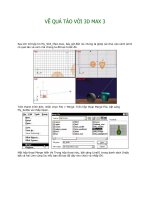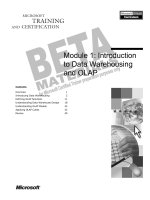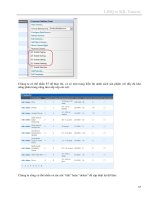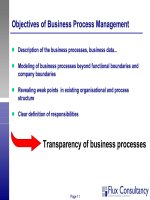Introduction to XSLT Concepts phần 5 pptx
Bạn đang xem bản rút gọn của tài liệu. Xem và tải ngay bản đầy đủ của tài liệu tại đây (72.27 KB, 10 trang )
Introduction to XSLT Concepts
slide 65
XPath Has Two Main Uses
C
First use: Addressing
C
addresses (finds) part of an XML document
C
can address any part of the tree from any other
C
(ask for something in an XML document (“gimme my footnote!”)
and get it back)
C
Second use in XSLT: for Testing/Matching
C
test whether a node in a tree matches a pattern
C
is this node a paragraph that is inside a footnote that has an attribute
called “footnote-type” with the value “legal”?
slide 66
You’ve Seen XPath in
match
Expressions
C
<xsl:template match="title">
Matches <title> elements
C <xsl:template match="scene/title">
Matches <title> elements that have a <scene> parent
C <xsl:template match="para[@type=’warning’]">
Matches <para> elements that have a type attribute that has a value
of “warning”
slide 67
XPath Can Be Very Complex
(all that power has a price)
child::slide[attribute::type="overview"]/child::list
[count(descendent::item) > 8]
preceding::slide[descendant::title
[contains(self::node(),
’Business’)]]
Thanks to Jeni Tennison for:
select="following-sibling::transaction
[@type = $type and substring(@date, 4, 2) != $month] [1]"
Page 35
Introduction to XSLT Concepts
Another Complexity:
Push-me Pull-you Stylesheets
slide 68
XSLT is
C
By design and default, driven by the XML input file
C
That means you tell it what to do, not how or when
C
Automatically recursive through the use of templates
slide 69
XSLT can be Written in Two Ways (1)
C
Way # 1 = Input-driven (called Push)
C
walk the input tree
C
match elements in input tree
C do something when you find a match
C This is what XSLT was designed to do
C This works the best (when it works for your data)
slide 70
XSLT can be Written in Two Ways (2)
C Way # 2 = Stylesheet driven (called Pull)
C more like a typical computer program
C walk the stylesheet
(which specifies the order of the output document)
C when it asks for data, go get it from the input tree
C Similar to some fill-in-the-blank programming languages
Pull stylesheets are most useful when you have very regular data
Page 36
Introduction to XSLT Concepts
slide 71
What is a Pull Stylesheet?
Let’s look at some XML for a menu
<specials-menu>
<menu-date>Friday, July 28, 2000</menu-date>
<spec-meat price="24.50">Pork chops with Chard
& Apples</spec-meat>
<spec-appetiz price="3.95">Seckel pears with
Gorgonzola and Walnuts</spec-appetiz>
<spec-soup price="6.95">Red and Yellow
Pepper</spec-soup>
<spec-fish price="18.50">Seared Achoo with Risotto
and Spinach</spec-fish>
<spec-pasta price="12.25">Wagon-wheels Alfredo
(with side salad)</spec-pasta>
<spec-sweet price="12.95">Strawberry and
Chocolate Tart</spec-sweet>
</specials-menu>
slide 72
Now Let’s Look at the Stylesheet
Here’s the XML file for that:
<html xmlns:xsl=" /> version="1.0">
<title>Today’s Menu -
<xsl:value-of select="//specials-menu/menu-date"/>
</title>
<h1> Specials
<xsl:value-of select="//menu-date"/>
</h1>
<h2>Appetizer</h2>
<ul>
<li>
<xsl:value-of select="//spec-appetiz"/>
</li>
</ul>
<h2>Soup</h2>
<ul>
<li>
<xsl:value-of select="//spec-soup"/>
</li>
</ul>
Page 37
Introduction to XSLT Concepts
<h2>Fish</h2>
<ul>
<li>
<xsl:value-of select="//spec-fish"/>
</li>
</ul>
<h2>Pasta</h2>
<ul>
<li>
<xsl:value-of select ="//spec-pasta"/>
</li>
</ul>
<h2>Entree</h2>
<ul>
<li>
<xsl:value-of select ="//spec-meat"/>
</li>
</ul>
<h2>Dessert</h2>
<ul>
<li>
<xsl:value-of select ="//spec-sweet"/>
</li>
</ul>
<br/>
<h3>Specials are available every day from opening until
exhaustion.</h3>
<p>Come see us anytime!</p>
</html>
Page 38
Introduction to XSLT Concepts
slide 73
And That Produced HTML like this:
Page 39
Introduction to XSLT Concepts
slide 74
Why Pull Can Be a Problem
C
XSLT was designed as a “data filter” language
(called side-effect free)
C
Stylesheets tell the processor what to do when it finds something
C
Processor controls the finding of things in the input tree
(when to do it)
C
Pull stylesheets
C
control both what and when
C
fight the design of the language
slide 75
Is Pull Always Bad?
C
Of course not
C might be the only way to do something
C might be the best way
C Pull is useful when
C output is in a specific order, not the order of input
(many database and transaction applications)
C data is very regular
C Not so good if
C data is irregular
C data order is unknown (like most text)
C hierarchy can change (like most text)
(Pull works best in a data environment)
Page 40
Introduction to XSLT Concepts
slide 76
Heads UP: XSLT and XPath 1.0, 1.1, 2.0
C
XSL 1.0 — The current version
C
XSL 1.1 — Aborted, does not exist any more
C
XSL 2.0 —
C
The coming thing (Draft Recommendation as of Jan 2006)
C
Not backwards compatible with 1.0
slide 77
What Was “Wrong” with XSLT 1.0
(To simplify greatly the programmer-style reasons)
C
Not really consistent with W3C XML Schema
C
Weakly typed and cast types automagically
C Making multiple output files was an extension, not built in
C Could not pass trees into templates or query result trees
C Had to extend the language to write your own function
(XSLT 1.0 has templates, not general functions)
C Grouping was difficult
C No regular expressions
Page 41
Introduction to XSLT Concepts
slide 78
XSLT 2.0: More Power; More Programmer
Responsibility
(this is all programmer stuff)
C
Multiple result documents
C
Strong data typing
C
Temporary trees can be accessed; XPath can see them
C
New serialization types and attributes to control things
like Unicode normalization
C
Grouping support
C
Support for user-defined functions
C
Regular expressions in match, replace, and tokenize functions
C
Schema import including substitution groups
slide 79
How to Deal with XSLT 1.0 and 2.0 (November 2005)
C Processors will have a switch, user chooses
C Mission critical is done in 1.0 (now)
C Many processors not up to 2.0 (that’s changing fast)
C Everyone learning and playing with 2.0
C Recommendation: If you aren’t a declarative languages geek,
learn XSLT 1.0 to get the template stuff down
then learn XSLT 2.0
Page 42
Introduction to XSLT Concepts
slide 80
How to Make XSLT Programmers
(out of yourself or your staff)
XSLT is
C
Fast to learn
C
Useful when you know even a little
C
Fast to write (great for prototyping, reports)
C
Powerful in XML problem space
C
Use as a toolkit, use in addition to java, perl , python, C++, icon
slide 81
XSLT is Also Really Easy But
C
Very simple language (under 30 commands)
C Getting started is easy
C Anybody can learn this (secretary, editorial staff, lawyer)
C XSLT is a declarative, side-effect free language
C processes “differently”
C templates recurse all by themselves
C If programmers have a procedural background,
they may have some habits to “unlearn”
Page 43
Introduction to XSLT Concepts
slide 82
Pull: The Big Beginner Mistake
C
Pull should be used sparingly
C
for special situations only
C
Best used on very regular, predictable structures (data)
C
Beginners use it for everything
C
How to spot this problem in your programmers’ stylesheets
C
uses <xsl:for-each> to force recursion
(instead of using templates, which recurse as designed)
C
uses <xsl:value-of> which
C
processes the text inside an element
C
(instead of <xsl:apply-templates>, which processes
both text the and embedded tags inside an element)
slide 83
Why Programmers Will Like Pull
C They are used to controlling the order of execution
C They don’t trust the stylesheet to “do it right”
C They need recursion, so they force it (instead of using it)
C They fight the template design
C Relational database folks forget about containment and mixed content
C Solution
C training
C at least one good book
C training
C write for different kinds of data
C training
Page 44









